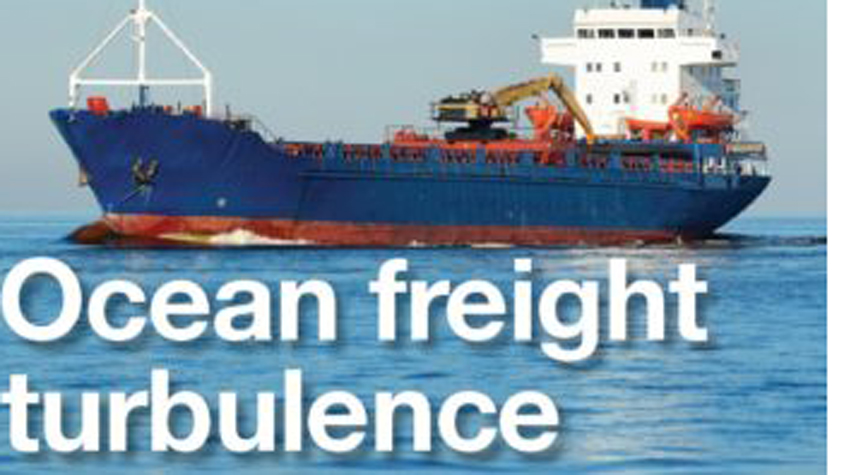 High Point, N.C. — In the face of a huge volume drop due to the COVID-19 pandemic, ocean freight lines have cancelled sailings on an “industrial scale” since February.
High Point, N.C. — In the face of a huge volume drop due to the COVID-19 pandemic, ocean freight lines have cancelled sailings on an “industrial scale” since February.
That’s according to a briefing last week from maritime research and consulting agency Drewry. After spiking in February, cancelled, or “blank” sailings, decreased between April and May by 12% overall, but in Transpacific trade key to home furnishings, blank sailings were up of 32%. Drewry reported the Transpacific trade will see 45 blank sailings this month, 55% of the total blank sailings for May.
Carriers have long used blank sailings to prop up pricing during times of weak demand. Just how much demand for home furnishings at retail in the coming weeks and couple of months is open to question, but manufacturers stateside needing materials as production resumes, importers setting up to flow goods, and retailers looking to stock for re-opening their stores should pay extra attention to ocean-freight capacity and scheduling these days.
Accommodating the near-term
The demand uncertainty could affect how ocean carriers accommodate near-term demand, especially in light of their efforts to boost container rates with blank sailings and fleet contractions.
“There is no magic answer, because it will be difficult to perfectly match up getting the ships back into service lanes as the demand ramps up,” said Peter Giorgio Jr., president of Global Logistics Solutions LLC and founding partner of Advantage Shippers Assn., which focuses on ocean and drayage rates for shippers.
With demand-sensitive pricing for shipping, he added, ocean carriers ‘lag’ the reposition of ships as long as possible to create an environment of under-capacity and pressure rates upward. “Importers who have been shut down for an extended period of time will undoubtedly be faced with potentially higher ocean rates to get their inventory levels back to where they are needed to service the anticipated pent up consumer demand coming out of the stay at home environment.”
Shippers can expect carriers to manage capacity with aggressive use of blank sailings continuing in the short term, according to Drew Wilkerson, XPO Logistic’s president of transportation, North America.
“Despite the sharp decline in Asian imports, this strategy has kept rates stable year-over-year,” he noted. “But when volumes start to surge — and we expect they will — the carriers will be very opportunistic in adding capacity.”
Rachel Shames, logistics services provider CV International’s director pricing and procurement, noted that orders for the current back-to-school rush, traditionally the second-strongest peak shipping season, are down across the board.
“There is concern in the ocean shipping industry that a peak season may not materialize at all this year,” she said. “Widespread uncertainty is resulting in drawn-out contract negotiations and forecast reductions. As such, the ocean carrier’s outlook currently is not great. They want to maximize return on deployed assets, which are quite expensive, so they need cargo.
“Furniture shippers that provide steady bookings in the near term/months to come will be a benefit to ocean carriers. Such shippers would be wise in the second half of the year, once broader demand rebounds and more space is needed, to remind ocean carriers how they were there for them in leaner times.”
Giorgio noted that carriers have a balancing act themselves when it comes to managing capacity to maintain their pricing rates, and there’s a potential upside there for shippers.
“It is all based on timing, and if carrier capacity increases quicker than the production shipping demands then the rates conceivably would be lower,” he said. “Let the dance begin.”
What to do now?
What can retailers do when it comes to communicating with their ocean carriers or freight forwarders to ensure adequate flow of goods in the next couple of months?
With states — and thus retail — reopening at different rates, retailers need to carefully gauge their expectations for demand.
“There is no doubt that the home furnishings world should benefit from consumer pent-up demand fueled by the economic stimulus dollars the government has or will provide,” Giorgio said. “You read about unemployment (payments) being higher than what many previously employed people were earning.
“The retailer that has inventory should be able to best capitalize on that extra consumer spending in the short term. Making bookings as soon as possible will give both the ocean carriers and freight forwarders a better feel for what demand lies out there and is in process.”
Giorgio typically recommends that clients not book any earlier than 10 days from desired ship date, but in the current environment, “I would recommend having the factories book as early as up to 30 days out so the demand can be seen by the entire supply chain. As well, all service providers will need to have visibility to your increased demand as soon as possible so all facets can be prepared to support the flow of goods in a timely and efficient manner.”
CVI also said earlier is better for bookings in its end-of-April market update for customers, recommending pre-booking at least six weeks in advance for adequate planning of allocation requirements and scheduling.
“It is extremely important for importers to have a multitude of booking options across various ocean alliances,” Shames said. “Non-vessel operating common carriers offer such a platform by contracting with a variety of carriers, to provide a wide range of service options and sailing dates. For most small- to medium-sized importers, the NVOCC route is the best way to go, given the value-added role such partners play, which gives shippers outsourced advantages and the ability to do more with less.”
Larger importers that take control of a shipment at the destination as beneficial cargo owners using their own logistics assets instead of utilizing a third-party source, Shames added, “should make sure they have partnerships in place with ocean carriers in each alliance, to ensure balance and the broadest array of options.”
Retailers should avoid overcommitting volume to ocean carriers so they maintain the ability to tap into flexible offerings from forwarders, said XPO’s Wilkerson.
“Accurately forecasting capacity requirements, making advanced bookings and using varied routings and modes will help insulate them from the lack of service integrity in the container shipping environment,” he said.
Watch the spot market
Demand uncertainty might impact the flow of goods as home furnishings stores and factories re-open from virus-related shutdowns. Shames at CVI believes it ultimately depends how fast consumer shopping and spending behavior approaches “normal” and when furniture buying becomes a priority.
“As such, considerable inventory disruption can be expected, as manufacturers are essentially guessing how much demand will materialize,” she said. “These are unchartered waters, and there are not forecasting models for this situation, so some inventory imbalance is expected as supply chain participants find their new normal.”
Larger furniture shippers with their own contracts with steamship lines as beneficial cargo owners make a minimum quantity commitment, a mutual understanding on how many containers the shipper needs and how much vessel allocation carrier will provide. Shames pointed out that should the shipper not actually ship the MQC over the course of a year, then “dead freight” penalties may apply.
“Given the business disruption associated with COVID-19, BCOs are now considering scaling back those MQCs, since they don’t really know what their business will look like for the balance of the year and don’t want to be in a position of overcommitting their ocean contracts,” Shames said.
“Therein lies the problem, given the ocean freight market could be setting up for quite a premium in the later part of the year,” he continued, adding that blank sailings keep the freight rate spot market in check during a period in which it might otherwise fall.
“In general, for many years global shippers had the upper hand in dealing with ocean carriers who have been introducing larger, newer ships in their quest for economies of scale and lower cost,” she said. “That relationship dynamic could change dramatically in the post COVID-19 market.
“While bunker fuel, a significant cost component in ocean shipping, is at historic lows, and (it) will likely remain at very competitive levels in the year ahead. But it is the aforementioned blank sailings that will cause the ocean freight spot market to sharply rebound when the economy starts to recover, and the carriers are very good at executing this.”
Blank sailings so far have reduced capacity by roughly 20% U.S. East Coast ports and 25% to U.S. West Coast ports.
“But when carriers’ blank sailings during periods of heavier demand, the spot market rises and ocean freight gets more expensive,” Shames said.
While shippers are signing ocean contracts at very competitive long-term fixed rates, she pointed out they are also signing more modest MQC levels, given they do not really know how much volume will materialize later in the year and do not want to overcommit.
“And if shippers need more space, which could be the case later this year given modest MQCs and higher demand, then they need to procure it in the spot market, which pays better margins for the carriers,” Shames said. “We could be heading towards a market in the second half of the year where a significant differential exists between long-term fixed ocean contract rates and the spot market.”


